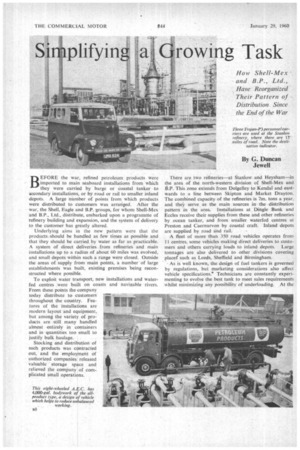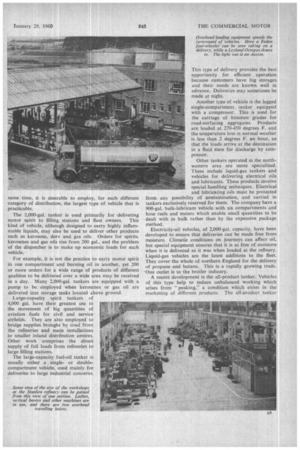B EFORE the war, refined petroleum products were imported to main
Page 42

Page 43

Page 44

If you've noticed an error in this article please click here to report it so we can fix it.
seaboard installations from which they were carried by barge or coastal tanker to secondary installations, or by road or rail to smaller inland depots. A large number of points from which products were distributed to customers was arranged. After the War, the Shell, Eagle and B.P. groups, for whom Shell-Mex and B.P., Ltd., distribute, embarked upon a programthe of refinery building and expansion, and the system of delivery to the customer has greatly altered.
Underlying aims in the new pattern were that the products:should be handled as few times as possible and that they should be carried by water as far as practicable. A system of direct deliveries from refineries and main installations up to a radius of about 60 miles was evolved, and small depots within such a range were closed. Outside the' areas of supply from main points, a number • of large establishments was built, existing premises being reconstructed where possible.
To exploit water transport, new installations and waterfed centres were built on coasts and navigable rivers, From these points the company today distribute to customers throughout the country. Features of the installations are modern layout • and equipment, but among the variety of products are still many handled almost entirely in containers and in quantities too small to justify bulk haulage. .
Stocking and distribution of such products was contracted out, ' and the employment of authorized companies released valuable storage space and relieved the company of complicated small operations. There are two refineries—at Stanlow and Heysham—in the area of the north-western division of Shell-Mex and B.P. This zone extends from Dolgelley to Kendal and eastwards to a line between Skipton and Market Drayton. The combined capacity of the refineries is 7m. tons a year, and the' serve as the main sources in the distrihution pattern in the area Installations at Dingle Bank and Eccles receive their supplies from these and other refineries by ocean tanker, and from smaller waterfed centres at Preston and Caernarvon by coastal craft. Inland depots are supplied by road and rail. .
A fleet of more than 350 road vehicles operates from Ii centres, some vehicles making direct deliveries to customers and others carrying loads to inland depots. Large tonnages are also delivered to other divisions covering place such as Leeds, Sheffield and Birmingham.
As is well known, the design of fuel tankers is governed by regulations, but marketing considerations also affect vehicle specifications. Technicians are constantly experimenting to evolve the best tank to meet sales requirements whilst minimizing any possibility of underloading. At the same time, it is desirable to employ, for each different category of distribution, the largest type of vehicle that is practicable.
The 2,000-gaI. tanker is used primarily for delivering motor spirit to filling stations and fleet owners. This kind of vehicle, although designed to carry highly inflammable liquids, may also be used to deliver other products such as kerosene, dery and gas oils. Orders for spirits, kerosenes and gas oils rise from 200 gal., and the problem of the dispatcher is to make up economic loads for each vehicle.
For example, it is not the practice to carry motor spirit in one compartment and burning oil in another, yet 200 or more orders for a wide range of products of different qualities to be delivered over a wide area may be received in a day. Many 2,000-gal. tankers are equipped with a pump to be employed when kerosenes or gas oil are delivered into storage tanks located above ground.
Large-capacity spirit tankers of 4,000 gal. have their greatest use in the movement of big quantities of aviation fuels for civil and service airfields. They are also employed to bridge supplies brought by road from the refineries and main installations to smaller inland distribution centres. Other work comprises the direct supply of full loads from refineries to large filling stations.
The large-capacity fuel-oil tanker is usually either a singleor doublecompartment vehicle, used mainly for deliveries to large industrial concerns. This type of delivery provides the best opportunity for efficient operation because customers have big storages and their needs are known well in advance. Deliveries may sometimes be made at night.
Another type of vehicle is the lagged single-compartment tanker equipped with a compressor. This is used for the carriage of bitumen • grades for road-surfacing aggregates. Products are loaded at 270-450 degrees F. and the temperature loss in normal weather is less than 2. degrees F. an hour, so that the loads arrive at the destination in a fluid state for discharge by cornpre.ssor.
Other tankers operated in the northwestern area are more specialized. These include liquid-gas tankers and vehicles for delivering electrical oils and lubricants. These products involve special handling techniques. Electrical and lubricating oils must be protected from any possibility of contamination, and carried in tankers exclusively reserved for them. The company have a 900-gal. bulk-lubricant vehicle with six compartments and hose reels and meters which enable small quantities to be dealt with in bulk rather than by the expensive package method.
Electricity-oil vehicles, of 2,000-gal. capacity, have been developed to ensure that deliveries can be made free from
moisture. Climatic, conditions on journeys can affect oil, but special equipment ensures that it is as free of moisture when it is delivered as it was when loaded at the refinery. Liquid-gas vehicles are the latest additions to the fleet. They cover the whole of northern England for the delivery of propane and butane. This is a rapidly growing trade.
One outlet is to the broiler industry.
A recent development is the all-product tanker. Vehicles of this type help to reduce unbalanced working which arises from "peaking," a condition which exists in the marketing of different products. The all-product tanker conforms with the regulations governing the carriage of spirit, but, with the addition of a pump and other equipment, can be changed over on a seasonal basis from one product to another.
There are 2,000-gal. and 4,000-gal. tankers in this class. Their adoption will reduce variety and lead towards standardization. Special vehicles have been designed for deliveries of Oil to households. Long lengths of hose are carried and pump delivery is metered:
Both rigid and articulated vehicles are used in the north-west. The greatest advantage of " artics " lies in the matter of cost. The life of a tank is some seven or eight years longer than that of a chassis, but it is seldom found practicable, because of improvements in design, to remount a tank on a new chassis. A semi-trailer tank, however, can be employed for its full life with more than one tractor. Sometimes there are opportunities for shuttle operation by which uncoupled semi-trailers can-be loaded.
Distribution in this area will be facilitated by a new storage and distribution depot now being built at Partington, near Manchester. This will be connected by two pipelines to the Shell refinery at Stanlow. It is foreseen that there will be an increasing demand for petroleum products for along time to come, and that road transport's role will expand.
A self-contained fleet is that at the Stanlow refinery itself,
where more than 5,000 people are employed with 1,000 others at the Thornton research centre, as well as many contractors' employees. Over 400 products are turned out, including over 250 grades of lubricating oil, bitumen and chemicals:.
The site covers about 1,800 acres and takes in 5m. tons of crude oil a year. There are 15 miles of roads, 20 miles of rail track and 700 miles of pipe. The refinery requires the same utility services as a town of 75,000 people, and its water and electricity consumption are greater than the city of Chester's.
The Shell Refining Co., Ltd., operate 145 light vehicles, including, for example, six Bedford-P6 platform lorries engaged upon internal work such as the transport of drums. These vehicles average up to 17.1 m.p.g. There are also two Bedford-P6 Duple-bodied 33-seaters, each of which covers about 1,000 miles a week shuttling visitors between Chester and Stanlow. Three Trojan-P3 personnel vehicles carry staff and mail from the refinery to "outposts." A Dennis refuse collector and a gully-emptier are in continuous use.
Maintenance shops are well equipped, and the servicing department checks 18-20 vehicles a day. All vehicles are inspected every eight weeks, as well as being greased every three weeks. Oil is changed at 1,500-mile intervals and injectors at 10,000 miles.






































































































